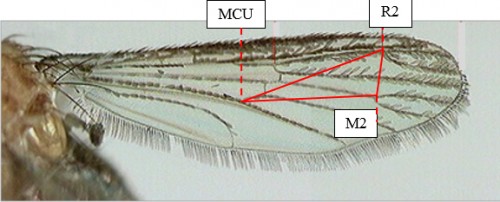Morphometry of three mosquito species vectors of West Nile Culiseta longiareolata Macquart 1838, Culiseta subochrea Edwards 1921 and Culiseta glaphyroptera Schiner 1864 collected at Collo (Northeast Algeria)
Author(s): Nour El Houda Boudemagh, Fatiha Bendali-Saoudi and Noureddine Soltani
Abstract: To identify the mosquito species competent for West Nile virus (WNV) transmission, we have proceeded to the morphometry study of three mosquito species belonging to the same genus Culiseta (Culiseta (Allotheobaldia) longiareolata Macquart 1838, Culiseta (Culiseta) subochrea Edwards 1921 and Culiseta (Culiseta) glaphyroptera Schiner 1864. These species have been harvested in the region of Collo (Northeast Algeria), which is characterized by a Mediterranean climate. Measurements of 32 structures considered important in the taxonomy of male and female adults, have been carried out. The exploitation of morphometric data of females and the statistical analysis showed significant differences concerning the width of the head, the length of the thorax, and the length of the tibia of the 3rd leg, respectively. Highly significant differences were revealed in the length of the palps and the length of tarsi of the 3rd leg. Very highly significant differences have been observed in the length of: pronotum; antennas; abdomen; wing; femur; tibia and tarsus of the 1st leg; femur; tibia and tarsus of 2nd leg; femur and tibia of 3rd leg. The width of: pronotum; antennas; palps; thorax; wing; tarsus of the 2nd leg; tarsus of the 3rd leg. For males, the statistical analysis indicated significant differences between the widths of: pronotum, femur and tarsus of the 1st leg. Highly significant differences were also noticed between the length of the abdomen and the width of the wing. Moreover, the test shows very highly significant differences concerning the length and the width of: palps; antenna; thorax; femur; tibia and tarsus of the 2nd leg; tarsus of the 3rd leg. The length of: pronotum; wing; femur; tibia and tarsus of the 1st leg; femur and tibia of the 3rd leg. On the other hand, the study of the wing parameters showed significant differences between the length and the width of the wings and the axis (Mcu-M2), (R2-Mcu). For males, significant differences between the length of the wings and the axis (R2-Mcu) were found.
 Fig.:
Fig.: The axes (MCU-M2), (M2-R2), (R2-MCU) of the wing
How to cite this article:
Nour El Houda Boudemagh, Fatiha Bendali-Saoudi, Noureddine Soltani. Morphometry of three mosquito species vectors of West Nile Culiseta longiareolata Macquart 1838, Culiseta subochrea Edwards 1921 and Culiseta glaphyroptera Schiner 1864 collected at Collo (Northeast Algeria). Int J Mosq Res 2018;5(1):12-18.



